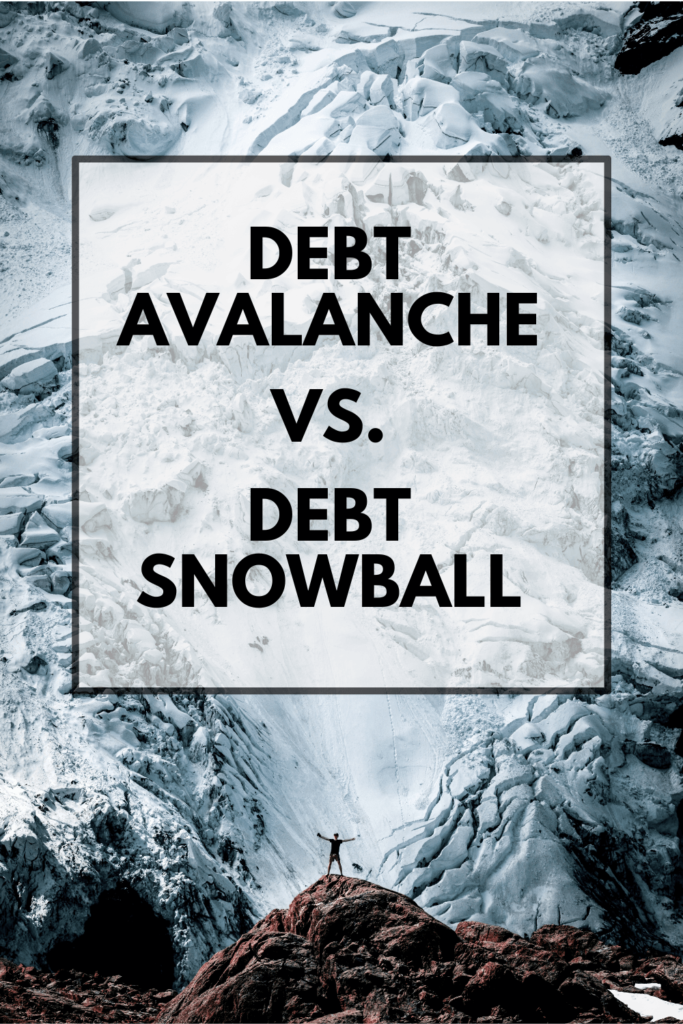The debt avalanche vs. debt snowball, which one is for you?
If you’re looking for the best way to pay off debt, the debt avalanche and debt snowball are a great place to start. Both methods represent strategies for paying off debt fast.
Knowing how each method works will help you make a decision on which strategy to use.
Key differences:
- The debt avalanche focuses on paying down debt from the highest to the lowest interest rate.
- The debt snowball focuses on paying down debt from smallest to largest amount.
Each method involves making a list of all debts and systematically paying them off. Both methods assume you can budget to make minimum payments on all debts AND pay extra on the debt you choose to pay down first (based on which method you go with).
Keep in mind the mortgage on your home is always left last. The debt we’re talking about includes student loans, credit card balances, medical bills, car notes, etc.
These methods were first popularized by financial guru Dave Ramsey and they serve many households to this day. They are both easy to understand and effective to implement.
Let’s take a closer look.

Debt Avalanche
The guiding principle for the debt avalanche is getting rid of the debt with the highest interest rate as fast as possible, followed by the next highest interest rate debt, and so forth.
We can all agree having debt is not a good place to be financially. Unless the debt is for an asset or investment that pays for itself, debt should be avoided if at all possible.
The thing about high-interest rate debt is the gnarly fact that interest rates dramatically extend how long you are enslaved to paying off the debt. Not to mention, how much you will end up overpaying for things in the long run.
Given most credit cards have 22% – 28% APR interest rates, it is extremely important to focus on paying off credit card debt as fast as possible.
This is where the debt avalanche method comes in.
Debt Avalanche Example
First, set up automatic payments to make minimum payments for each debt you have.
Next, assess your spending plan to determine how much extra you can put down on debt. The debt with the highest interest rate gets a minimum payment PLUS any extra money you can spare for paying down debt. Follow these steps until all debts are paid off.
Example scenario, say you have three debts you need to pay off:
- $5,000 at 18% interest
- $2,000 at 22% interest
- $1,200 at 10%
With the debt avalanche method, the extra payments would go towards the $2,000/22% debt first, the $5,000/18% second, and the $1,200/10% last.
While it will take longer to pay off the $2,000 vs. $1,200 debt, the avalanche method is all about getting rid of the highest interest rate first. 22% interest is significantly different compared to a 10% interest rate. In the long run, you’ll pay significantly less interest using the debt avalanche method.
Debt Snowball
The guiding principle of the debt snowball method is to get a win as fast as possible.
This way, you can start rolling the debt-payment snowball down the hill as quickly as possible to gain traction and pay things off ASAP. The main benefit of the debt snowball method is that it is easier to get motivated and helps you see the light at the end of the tunnel faster.
The idea behind the debt snowball is to dump every extra dollar on the smallest debt and work from there. This method highlights creating momentum as fast as possible. You’ll pay your first debt off much faster than the debt avalanche.
Targeting the lowest-hanging fruit is the best method for boosting morale the fastest. Plus, the faster you pay off the lowest balance, the faster you can put that extra payment toward the next debt on the list.
Debt Snowball Example
Back to our example scenario, say you have three debts you need to pay off:
- $5,000 at 18% interest
- $2,000 at 22% interest
- $1,200 at 10%
With the debt snowball method, the order of operations would be to pay off the $1,200/10% debt first, the $2,000/22% debt second, and the $5,000/18% debt last.
While the 22% and 18% debts would grow in more interest the longer you just paid the minimum payment, the trade-off is being able to completely eliminate the $1,200 balance.
End of story.
Debt Avalanche vs. Debt Snowball Pros and Cons
Pros Debt Avalanche:
- Reduces the interest paid over time, i.e., saves money
- Works well with those who like to budget
Cons Debt Avalanche:
- Requires attention to detail with determining APR percentages
- Takes more motivation to pay down debt longer before getting a win
Pros Debt Snowball:
- Easiest method to pay off debt fast
- Helps with motivation
- Works well with those who don’t have as much money to spare
Cons Debt Snowball:
- Takes longer to pay off debt
- Ends up making you pay extra in interest
So, Which One is for You? The Debt Avalanche or the Debt Snowball?
The answer is based on your particular situation.
In the best-case scenario, you’d use the Debt Avalanche method because it reduces the overall amount of interest paid over time. You may be a good candidate for the debt avalanche if:
- you are good at paying attention to details
- you can budget a consistent amount of money for paying off debt
- you don’t think you’ll lose motivation if it takes time to pay off your first debt
- you have at least a $1,000 emergency fund buffer
On the other hand, if you don’t have a consistent flow of income that allows regular debt payment, the debt snowball is the way to go. You may be a good candidate for the debt snowball if:
- you want to pay off the first debt fast and boost your motivation
- you have a little money to spare to put towards debt each month
- you don’t have a consistent flow of income
With the debt snowball, not only do you get the win faster, but if you only have a little money to spare it is the quickest way to delete an entire payment. This will then free up more money to pay off other debts.




